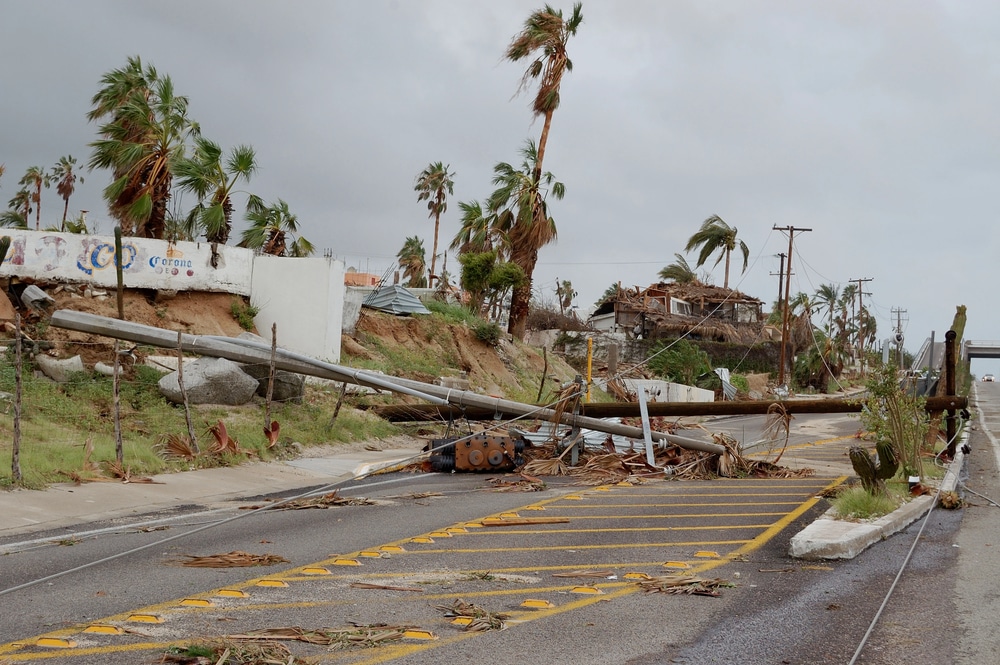Two weeks ago, Hurricane Helene slammed into the Deep South and parts of Appalachia, bringing devastating floods to a region often spared from strong hurricanes. A variety of factors combined to make Helene an especially dangerous storm. First, it formed over the Gulf of Mexico, where waters tend to be warmer than the Atlantic. Second, the globe is currently experiencing a transition to La Niña conditions where unusually cold ocean temperatures in the Pacific bring about all sorts of effects on the weather.
Specifically, as it relates to hurricanes, La Niñas decrease what’s known as vertical wind shear over the Atlantic and Gulf of Mexico. Think of vertical wind shear as the difference in wind between the surface and higher altitudes. The reduced vertical wind shear we’re experiencing right now made it easier for Helene to grow into a large, coherent, vertical structure and for the warm, moist air fueling it to rise undisturbed.
The third factor that made Helene especially dangerous for areas far inland was the fact that it followed closely behind another rainstorm. While far less dramatic than Helene, the first storm dumped a lot of rain on the region that oversaturated the ground. After Helene made landfall, instead of being drained of energy, the wet surface continued to fuel the storm as it moved up through Georgia into the Appalachian mountains.
Finally, the Appalachian mountains themselves drove the storm upward to a higher altitude—which cooled the storm quickly. Colder air cannot hold as much water as warmer air, so the result was even more torrential precipitation in the mountainous western Carolina region.
Together, all these factors combined to bring about a storm that dumped six months’ worth of rain on the towns and villages of western North Carolina in a matter of hours. The buildings, roads, and ground itself were unable to handle it. Flash floods and landslides devastated the region and so far 115 are confirmed dead in North Carolina alone, with many more missing.
The death toll across all states stands at 235 but is expected to climb. And with another major storm—Hurricane Milton—expected to hit Florida late Wednesday, we may soon see even more communities devastated by extreme weather.
But because all this destruction is happening with only a few weeks to go before election day, national politicians are clearly focused most on how to use these disasters to benefit politically.
Besides burdensome visits to affected areas, cheap photo ops pretending to do hands-on work, and staged briefings that are clearly more about optics than substance, the political establishment and its preferred candidate, Kamala Harris, have predictably used the storms to try and terrify us about climate change.
The main talking point that’s being disseminated through establishment-friendly outlets like The New York Times is that Hurricane Helene’s impact on areas far from the coast demonstrates that none of us can “hide from climate change.” That nowhere in the country is safe unless we finally wake up and give the government more control over energy production.
The false assumption that is heavily implied in articles like these and most rhetoric you’ll see from politicians acting concerned about the climate is that dangerous weather can and will go away if we only listen to the establishment-approved experts and fall in line.
A world without dangerous weather is an imaginary ideal. Press even the most ardent climate activists, and they’ll admit as much. The actual claim of most establishment-approved climate scientists is that human activity has generated a marginal increase in the frequency and intensity of extreme weather and that a total elimination of emissions could eventually bring global trends back in line with the natural frequency and intensity of such events.
But a world with marginally better weather would still have hurricanes, wildfires, heat waves, and all the other maladies we’re so often led to believe only plague us because we burn fossil fuels. So, if we’re serious about tackling the problems caused by dangerous storms and other natural disasters, the solution lies in better adapting to bad weather, not pretending we can eliminate it.
Fortunately, humans are very good at adapting to bad weather. And, while we have been for most of our history, we have become incredibly good at it in the last two hundred years thanks primarily to one thing—the economic growth that resulted from the Industrial Revolution.
Economic growth is not just some metric for measuring business activity. It reflects the creation of the wealth that has allowed humans to not only survive but live comfortably in nearly every region on earth. Thanks to a robust energy industry and modern HVAC systems, there are bustling cities all the way from arid deserts to the frigid taiga. Industrial-grade concrete and steel, along with our lack of reliance on window ventilation, also allow us to build durable buildings that make extreme weather much more survivable. Wealthy areas are even able to adapt well to rapid changes in the climate. For instance, New York City—a coastal city—has been adding land mass as the sea level rises.
This is all to say that the problems often ascribed to climate change are fundamentally problems of poverty.
Fortunately, we already know what solves poverty: market institutions grounded in a private property norm. Unfortunately, those are the very institutions the so-called environmentalist movement has set its sights on.
Most people around the world, including many in our own country, do not yet enjoy the safe, comfortable, stable living conditions I laid out above. And that needs to change. But when disasters like Hurricane Helene ravage areas these people live in, that ought to drive us to recommit to the institutions and practices that have made so many of us safer from natural disasters. Not to follow the siren call to reject those institutions out of some false hope that extreme weather will disappear.
This article was originally featured at the Ludwig von Mises Institute and is republished with permission.






























